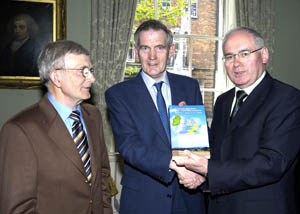|
The increasing concern for the impact of agricultural activity on the environment and on climate systems has widened the scope of agricultural meteorology in recent times and has attracted much attention and debate. However the reverse role � that of climate and weather on agricultural activities � is a much older subject matter and one that impinges on the daily, seasonal and long-term fortunes of everyone associated with Irish agriculture.

Pictured
at the launch of Climate, Weather and Irish Agriculture are Co-Editors Tom
Keane, formerly of Met �ireann and Jim Collins of the Department of Crop
Science, Horticulture and Forestry, UCD, presenting a copy to Noel Ahern
Minister of State of the Environment, Heritage and Local Government.
|
|
In order to document the current state of knowledge the AGMET group
(the joint working group on applied agricultural
meteorology) has launched a comprehensive book for anyone involved in the study and practice of, or those simply interested in, the impact of climate and weather on Irish agriculture and the environment.
Launched recently (Wednesday 5th May 2004) by the Minister of State of the Environment, Heritage and Local Government, Noel Ahern TD, the second edition of Climate Weather and Irish Agriculture deals with a wide range of issues that impact on agricultural production in its widest sense. These include weather measurement; climate, soil and land use; the influence of weather on diseases and pests of crops and animals; and the likely effects of climate change on agriculture and the introduction of new crops.
Edited by Tom Keane, formerly of Met �ireann, and Jim Collins of the Department of Crop Science, Horticulture and Forestry, UCD, (with associate editors Klare Finkele of Met �ireann and Michael Walsh of Teagasc), Climate, Weather and Irish Agriculture includes contributions from the leading meteorologists, agricultural scientists, pathologists and hydrologists in Ireland. Over its 400 pages and 13 chapters, the book focuses on giving a clear understanding of the various elements that make up our climate and the impact these have on field crops, horticulture, forestry and animal production.
�The first edition of Climate, Weather and Irish Agriculture, which achieved international acclaim, was published over 18 years ago and since then there has been considerable change in the way meteorological data is interpreted and how it meets the needs and practices of Irish Agriculture,� said co-editor Jim Collins of the Faculty Agriculture, UCD.
�The motivation for updating Climate, Weather and Irish Agriculture stems from a need to incorporate new research, technological advances and changed priorities in Irish agriculture. There is an ever-increasing concern for the environmental impacts associated with agricultural production, especially those likely to affect our three essential resources � soil, water and climate. Anyone wishing to find the scientific facts behind relationships between
climate-soils-crops-animals- machines, and our surface and ground waters and the air around us, will find them in this book. The concluding chapter outlines the likely impacts that future climate change may have on the agricultural scene in this country�
Climate, Weather and Irish Agriculture has established itself as the standard reference book for the effect of climate on agriculture in Ireland and in most countries of temperate latitudes. This second edition will be indispensable for anyone with a professional or personal interest in this area, especially those in teaching and research.
Climate, Weather and Irish Agriculture is published by AGMET and is available for �20 plus postage (�4) from AGMET c/o Faculty of Agriculture, UCD, Belfield, Dublin 4 (01 7167720) or AGMET c/o Met �ireann, Glasnevin, Dublin 9 (01 8064204).
5 May 2004

|

